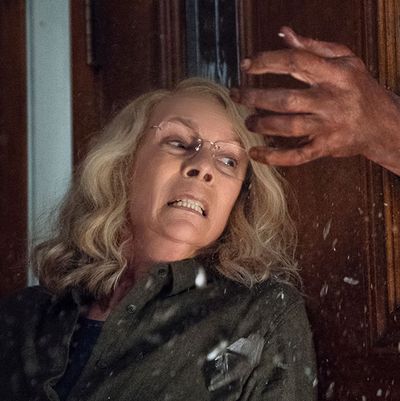
If you don’t think it’s fabulous that indie darling David Gordon Green has made a sequel to John Carpenter’s Halloween (1978) that pretends that all those other miserable sequels and remakes never happened and that Michael Myers was actually caught and institutionalized that very Halloween night in 1978 and that the lone surviving babysitter, Laurie Strode (Jamie Lee Curtis), ended up a profoundly damaged, twice-married prepper waiting for the day when she could bring Michael down once and for all — well, we have nothing to talk about then, do we?
Carpenter’s Halloween might be madly overrated, but it remains the smoothest, shapeliest, and most entrancing of all dumb hack-’em-ups. (I first saw it at a drive-in on the Berlin Turnpike outside Hartford, Connecticut, in 1978. Oh, what a night.) Green demonstrates respect for both its genius and its dumbness. He hasn’t set out to transcend the original, to make something that isn’t fundamentally a dumb hack-’em-up: He and co-screenwriters Danny McBride and Jeff Fradley even seem to go out of their way to write Carpenter-esque clunkers for the two-steps-behind cops as well as the hammy successor to Donald Pleasance’s keening shrink, Loomis.
But Green gets the great stuff, too. He shows a deep appreciation for Carpenter’s imagery and tempo, for the way in which the camera glides alongside the latest crop of high-school girls making their way along the tidy sidewalks of Haddonfield, Illinois, to Carpenter’s metronomic score — tracking-camera music that subtly evokes the hidden tracker. (Carpenter’s themes are back for the umpteenth time, spruced up by his son Cody and Daniel A. Davies.)
Green has even greater reverence for Michael, formally known as “the Shape,” the iconic boogeyman on whom we can project almost anything.
(All we really know is that he’s a fan of kitchen knives and has a hard-on for babysitters dating back to the night that his big sister left him downstairs while she had sex.) There are shots of the Shape in this Halloween that are beautiful, in which he’s framed by window sills and trees, his mask faintly glowing.
Jamie Lee Curtis’s Laurie is now a bespectacled grandma with a mop of straggly hair but still, after 40 years, unable to heal from the trauma she suffered as a teenager. When she leaves her gated, booby-trapped house in the woods, she has one eye out for the nearest escape route and the other for the nearest glass of wine. There’s joy in this performance — you could tell how happy Curtis was when she came onstage to prolonged cheers at the film’s midnight premiere at the Toronto International Film Festival. Curtis has lived with Laurie Strode for so long that she must have been itching — like Laurie herself — to go back and do it right, suppressing memories of that tacky hospital bloodbath (Halloween II) as well as the middling-to-lousy Halloween H20: 20 Years Later, in which she played a headmistress. (It did feature Michelle Williams and Joseph Gordon-Levitt!) Of Halloween: Resurrection, in which Michael finally does Laurie in, the less said the better.
This new Halloween is the #MeToo Halloween, the one that says the body never forgets the memory of assault, and that the trauma is passed down to future generations in all sorts of unpleasant ways. Judy Greer plays Laurie’s daughter, Karen, who was whisked out of her mother’s custody at an early age — but not before she’d been taught how to shoot and fight and look for boogeymen behind every tree. (The character is a bit of a drag but has a punch line worth waiting for.) Karen and her skeptic husband treat Laurie as a nutter and try to keep her away from her granddaughter, Allyson (Andi Matichak), but this Halloween, Laurie is sniffing the air and smelling a psycho killer, and soon she’s tracking Haddonfield teenagers, too.
The reason for her heightened sense of danger is that Michael is being transferred to another mental-health facility, which is never a good idea, but no ever learns. The Turkish actor Haluk Bilginer is Sartain, the new Loomis, whom Laurie describes, helpfully, as “the new Loomis.” Unlike Loomis, he doesn’t spout lines about eeeevil. He’s obsessed, instead, with understanding Michael’s addiction to killing. He’s a wackadoodle. Almost as trying is an obnoxious Brit podcaster, Martin (Jefferson Hall), and his more tolerable female colleague, Dana (Rhian Rees), who visit the high-security asylum before Michael’s scheduled transfer. Martin has the peculiar idea that he can get Michael (the totemic James Jude Courtney, seen only from behind) to speak at last by waving his old mask in front of him. Never a good idea but no one ever learns.
Since Green’s debut with the arty, deeply humanist George Washington in 2000, he has gone in an entirely different direction, showing a penchant for madcap black comedies. But traces of humanism remain — an obstacle when you’re making a hack-’em-up, in which the supporting characters are traditionally just fodder for the hacker. I admire Green’s resistance to turning the murders into spectacles. In many cases, we like the people who are killed — their deaths have a sting. No one yells, “Cool!” until close to the end, when there’s a rousing head-stomping involving someone we really hate. I’ll give Green that one. He earned it.
Green’s Halloween doesn’t have the geographical simplicity — the elegance — of Carpenter’s. It’s a bit all over the place. But I love how he takes memorable images from the original and turns them on their heads, and how Michael, after being knocked on his ass, once again executes a perfect sit-up. After a purposefully slow start, the movie builds and becomes relentless. Maybe you can’t go home again, but in the age of fanboy auteurs, you can go back to Haddonfield.


